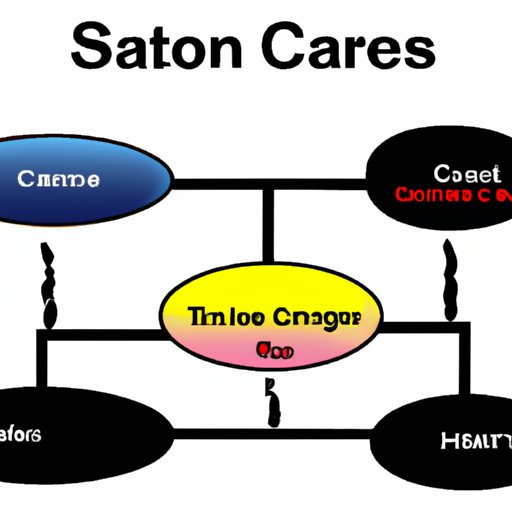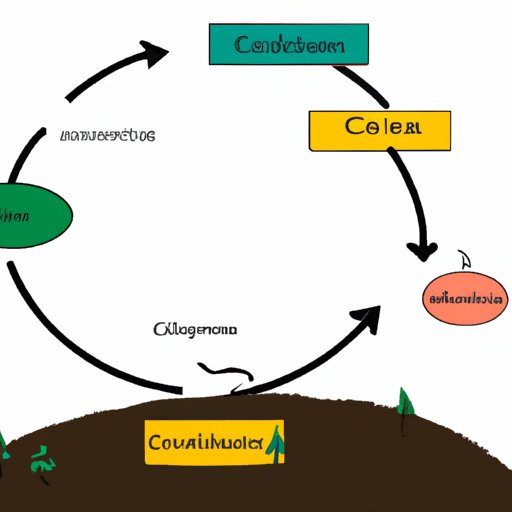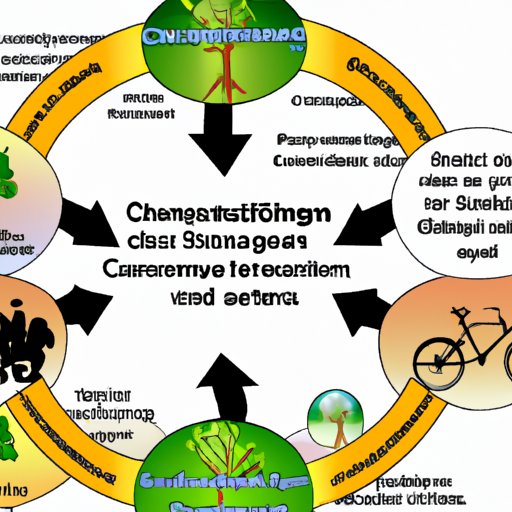Introduction
The carbon cycle is an essential part of the Earth’s climate system. It is the process by which carbon is exchanged between the atmosphere, biosphere, hydrosphere, and lithosphere. This cycle helps to regulate the global temperature, as it is responsible for the transfer of energy from the sun to the atmosphere and back again. In order for the cycle to remain balanced, there must be a balance between the sources and sinks of carbon.
Explaining the Carbon Cycle Step-by-Step
The carbon cycle can be broken down into four main processes: photosynthesis, respiration, combustion, and decomposition. Photosynthesis is the process by which plants use energy from the sun to convert carbon dioxide into glucose. This glucose is then used by the plant for energy or stored as starch. Respiration is the opposite of photosynthesis and is the process by which plants and animals release energy from stored glucose and produce carbon dioxide. Combustion is the burning of fossil fuels, such as coal and oil, which releases large amounts of carbon dioxide into the atmosphere. Decomposition is the breakdown of organic matter by bacteria and fungi, which releases carbon dioxide into the atmosphere.

Outlining the Different Carbon Sources and Sinks
The sources and sinks of carbon are divided into two categories: those that store carbon (sources) and those that remove carbon from the atmosphere (sinks). Oceans are one of the largest sources of carbon, as they absorb up to 40 percent of the carbon dioxide released into the atmosphere. Plants are another major source of carbon, as they capture carbon dioxide during photosynthesis and store it as biomass. Animals are also a source of carbon, as they consume plants and store the carbon in their bodies. Fossil fuels are formed from the remains of ancient plants and animals and are a major source of carbon when burned. Soil is another important source of carbon, as it stores much of the carbon released from decomposing organic matter. Finally, the atmosphere is both a source and a sink of carbon, as it contains carbon dioxide and absorbs some of it from other sources.
Examining the Role of Human Activity in the Carbon Cycle
Human activities have had a significant impact on the carbon cycle. The burning of fossil fuels is one of the most significant sources of carbon dioxide, as it releases large amounts of the gas into the atmosphere. Deforestation is another major contributor to the release of carbon dioxide, as trees are removed and not replaced, leading to the loss of carbon-storing vegetation. Agriculture is also a major factor in the release of carbon, as soil is disturbed and carbon is released into the atmosphere.
Discussing the Impact of Climate Change on the Carbon Cycle
Climate change has had a profound impact on the carbon cycle. As temperatures rise, atmospheric carbon dioxide levels increase, as more is released from sources and less is absorbed by sinks. Melting Arctic ice has also had an impact, as the dark ocean water absorbs more heat than white ice and snow, leading to further warming and increased atmospheric carbon dioxide levels. Additionally, ocean acidification is occurring as more carbon dioxide is absorbed by the oceans, leading to a decrease in pH levels and making it difficult for many marine organisms to survive.

Describing the Interaction Between the Carbon Cycle and Other Earth Systems
The carbon cycle is closely linked to many other Earth systems, such as the water cycle, nitrogen cycle, and phosphorus cycle. For example, the water cycle helps to transport and redistribute carbon around the globe, while the nitrogen and phosphorus cycles help to regulate the amount of nutrients available to plants and other organisms. Additionally, these cycles all interact with each other, as changes in one can cause changes in the others.

Investigating the Benefits of a Healthy Carbon Cycle for Humans and Nature
A healthy carbon cycle is essential for humans and nature. A balanced cycle helps to improve air quality, reduce greenhouse gas emissions, and mitigate global warming. It also helps to maintain biodiversity by providing the necessary nutrients for plants and animals to thrive. Additionally, a healthy cycle helps to maintain soil fertility, which is vital for food production.
Conclusion
In conclusion, the carbon cycle is an essential part of the Earth’s climate system. It involves the exchange of carbon between the atmosphere, biosphere, hydrosphere, and lithosphere. Human activities, such as burning fossil fuels and deforestation, have had a significant impact on the cycle. Climate change has also had an effect, as increasing temperatures and melting Arctic ice have led to higher atmospheric carbon dioxide levels. The cycle is closely linked to other Earth systems, such as the water cycle, nitrogen cycle, and phosphorus cycle. Finally, a healthy carbon cycle is essential for humans and nature, as it helps to improve air quality, reduce greenhouse gas emissions, and maintain biodiversity.
(Note: Is this article not meeting your expectations? Do you have knowledge or insights to share? Unlock new opportunities and expand your reach by joining our authors team. Click Registration to join us and share your expertise with our readers.)
